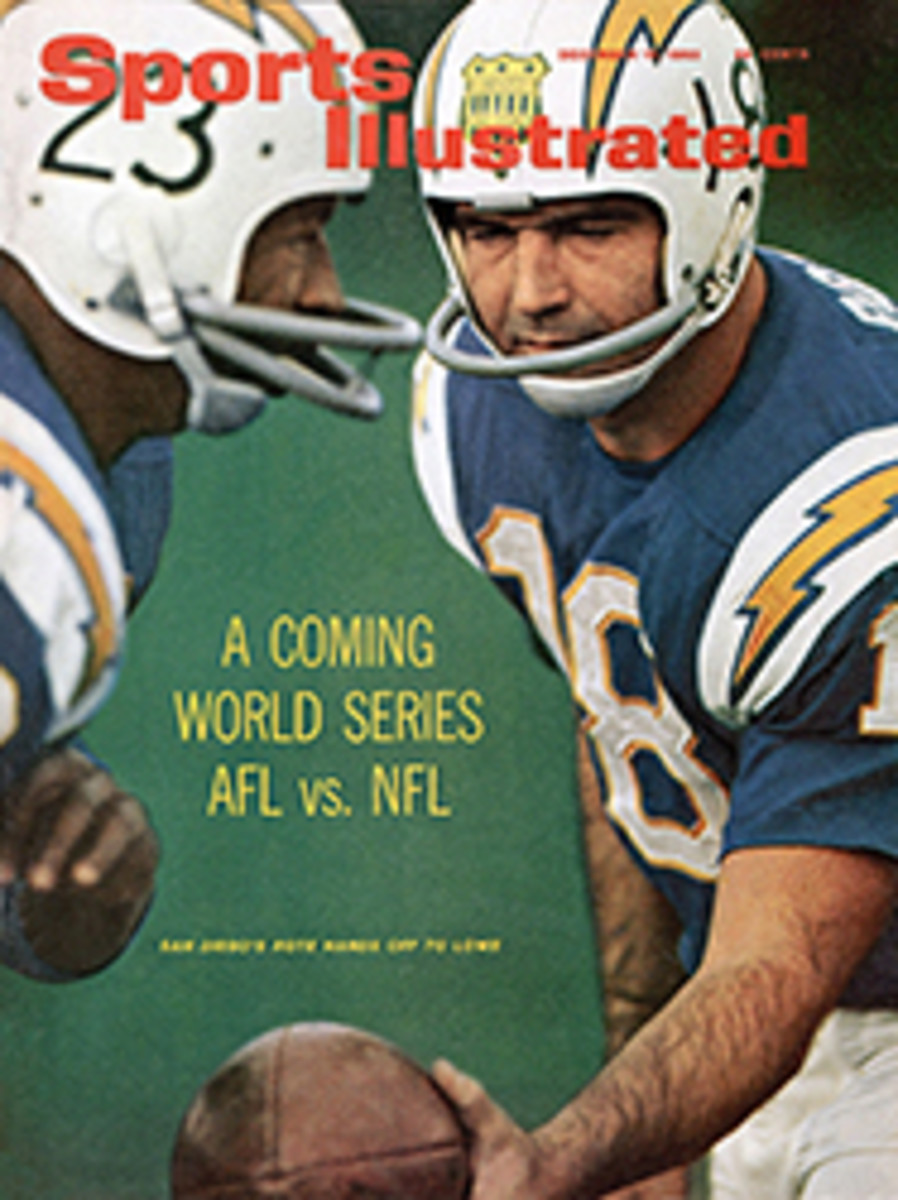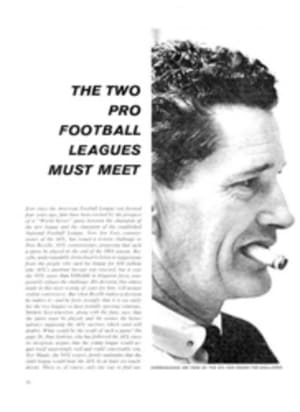
RIDICULOUS! THE NFL BY 50 POINTS
If the champions of the National Football League were to play the champions of the American Football League this year or next, it would be a mismatch that might be compared with the two Sonny Liston-Floyd Patterson heavyweight championship fights.
The 1963 NFL champions—Chicago Bears, Green Bay Packers, New York Giants, Pittsburgh Steelers, to name the possibilities—would defeat the AFL champions, the San Diego Chargers, to name the probability, by a margin of from 40 to 50 points.
This may, to AFL rooters, seem a massive exaggeration. Unfortunately for them, the facts of pro football life substantiate it.
The three factors most important in determining pro football excellence are passing, defense and depth, and in these the AFL is far behind the NFL. When Pete Retzlaff, the NFL player representative, stated recently that the AFL was still three years away from matching the NFL in strength, he was just about right. Retzlaff had no ax to grind; it is not in the interest of any NFL player to be hypercritical of the other league. First, the birth of the AFL boosted the average pay for all players a good 25%. Second, the AFL provides a pleasant haven for elderly NFL players—some 57 NFL rejects dot the rosters of AFL clubs. Nine former Baltimore Colts made the squad of the New York Jets this year and helped boost that club from a hopeless last in 1962 to a lively team and an early contender in the Eastern Division in 1963.
But to return to the World Series game. Undoubtedly the most important single player on any pro football team is the quarterback, and it is here the NFL has an enormous edge. Of the nine leading quarterbacks in the AFL (Oakland alternates two), seven are former NFL quarterbacks, only two of whom—San Diego's Tobin Rote and Boston's Babe Parilli—were ever considered starters. Jack Kemp of Buffalo, who is having a good year, was never better than third string with Pittsburgh and San Francisco during his brief career in the NFL. Rote, in 1957, replaced the injured Bobby Layne and led Detroit to a championship. But his record during his final year in the NFL—1959—is more indicative of the reason Detroit made no effort to prevent him from playing out his option. That season Rote completed only 62 of 162 passes for an anemic 38.5%. He threw five touchdown passes, but against that had an almost incredible number of passes—19—intercepted.
Therefore, Rote's record as an AFL quarterback this year serves as a neat indictment of AFL pass defenses. He ranks first in the league, just ahead of Len Dawson (former Cleveland Brown) and Kemp. Rote has thrown more passes than he did for Detroit (253 against 162), had fewer intercepted (15 against 19), increased his percentage of completions (.608 against .385) and thrown almost four times as many touchdown passes (19 against 5). Can it be that Rote, a 14-year man, has improved that much in the four years since he left the NFL? Not a chance.
It is not surprising that the pass defenses in the AFL are much more porous than the veteran units in the NFL. It takes roughly four years for a secondary, playing together, to reach maximum efficiency. The AFL has been in operation only four years; most of its defensive secondaries have been juggled each year as new players were added, either from NFL cuts or from the draft. Again, the four-year figure is predicated upon a team getting a fair share of the new talent out of college. This the AFL clubs have not been able to do.
The fact that the NFL clubs have been outbidding the AFL for most of the wanted college seniors each year has prevented the AFL teams from building up sufficient depth. When the AFL started, the NFL had been in business for 40 years; every team had a nucleus of experienced players. The NFL teams drafted to shore up weak spots; the AFL had to draft entire teams. The veterans in the AFL are players who, for one reason or another, have been deemed incapable of any longer meeting the standards of the NFL. Since the player pool available for the AFL is the same as that for the NFL, AFL teams, for the last four years, have gotten far less of the nation's best football players than the NFL.
It is not surprising, then, that the bench strength of the best AFL team does not compare to that of any team in the NFL, let alone the top NFL teams such as the Packers and the Giants. The Packers, victims of a mass of injuries this season, proved just how essential good depth can be.
In this mythical World Series game, the superiority of the NFL quarterback, throwing against the obviously weaker AFL defenses, coupled with the veteran NFL defense, pitted against what must be considered at best a mediocre (by NFL standards) quarterback, would be enough to guarantee an overwhelming victory for the NFL.
But consider what this would do for the running games. The AFL, under devastating air attack, would, of necessity, have to spread its defenses, opening runing routes for great backs like Jim Taylor or Jim Brown. The NFL defense, with the AFL passing contained, could set up to stop the AFL running. The game would turn into a rout.
In time, the AFL can probably field a team strong enough to give the NFL champion a struggle. But that time is not now or next year. It is not for several years.

